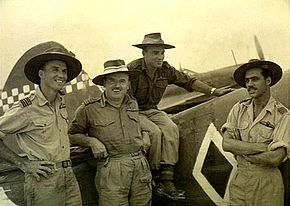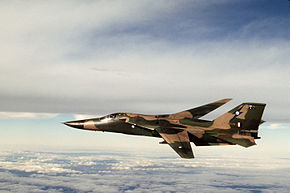Ian Dougald McLachlan
Ian Dougald McLachlan | |
|---|---|
North-Eastern Area Command (1951–53) (1957–59)Training Command Supply & Equipment Branch (1964–68) | |
| Battles/wars | World War II
|
| Awards | Mentioned in Despatches |
| Other work | Consultant, Northrop |
Raised to acting
Early career
The son of Dugald and Bertha McLachlan, Ian McLachlan was born in the
Enlisting in the Air Force on 10 December 1930, McLachlan completed his flight training the following year.
Combat service
Middle East

Sailing via
Described by historian Alan Stephens as "acerbic but capable", McLachlan led No. 3 Squadron through the
McLachlan was awarded the
South West Pacific
In 1942 McLachlan took command of

By June 1943, McLachlan had been promoted group captain and given command of No. 73 Wing. He established his headquarters at Goodenough Island, where he was responsible for organising the wing into a fighter formation consisting of No. 76 Squadron (Kittyhawks), No. 77 Squadron (Kittyhawks) and No. 79 Squadron (Spitfires). As well as providing local air defence, and fighter escort for Australian bombers, the Kittyhawks were armed with incendiary and general-purpose bombs so that they could engage in ground attack missions, a practice that had already been employed by Commonwealth forces in the Middle Eastern theatre.[26] In August, the wing transferred to Kiriwina, and No. 9 Group's other combat formation, No. 71 Wing, took over responsibility for Goodenough.[27][28] Appointed senior air staff officer (SASO) at No. 9 Group, McLachlan handed over command of No. 73 Wing to Wing Commander Gordon Steege in October 1943.[3][29] Towards the end of his posting to No. 9 Group, McLachlan told its former commander, Air Commodore Joe Hewitt, that the USAAF was "leaping ahead" of the RAAF, which was being left to "clean up the remnants" of Japanese resistance. He feared that Australian fighter pilots especially would be "increasingly restless if the Americans took all the fighting plums". Barely a year later, morale among senior RAAF fighter pilots had dropped to such an extent that eight of them tried to resign their commissions in the so-called "Morotai Mutiny".[30]
In March 1944, McLachlan took charge of
Post-war career

Following the end of hostilities, McLachlan volunteered to serve with the
As AOC Training Command, McLachlan undertook two reviews that would have, according to the official history of the post-war RAAF, "a significant effect on the Air Force of the 1960s".

McLachlan was appointed
Later life
McLachlan completed his term as Air Member for Supply and Equipment on 23 July 1968 and retired from the RAAF; he was divorced from his wife the same year.
Notes
- ^ a b c d e Howie, Who's Who in Australia 1992, p. 793
- ^ Gillison, Royal Australian Air Force, p. 110
- ^ a b c d e f g h "Air Vice-Marshals (L–Z)". Royal Australian Air Force. Archived from the original on 1 June 2011. Retrieved 20 July 2016.
- ^ a b c Coulthard-Clark, The Third Brother, pp. 196–197
- ^ Moore, Duntroon, pp. 64–65
- ^ a b "McLachlan, Ian Dougald". World War 2 Nominal Roll. Archived from the original on 11 October 2016. Retrieved 20 July 2016.
- ^ a b c d e f "Air Vice Marshal Ian Dougald McLachlan". Australian War Memorial. Retrieved 20 July 2016.
- ^ a b Roylance, Air Base Richmond, p.123
- ^ a b c Stephens, The Royal Australian Air Force, p. 80
- ^ Herington, Air War Against Germany and Italy, p. 57
- ^ Herington, Air War Against Germany and Italy, p. 100
- ^ Thomas, Gloster Gladiator Aces, pp. 44–46
- ^ "Fighter Operations – North Africa and the Middle East". Australian War Memorial. Retrieved 20 July 2016.
- ^ "Recommendation: Distinguished Flying Cross". Australian War Memorial. Retrieved 20 July 2016.
- ^ "No. 35073". The London Gazette. 11 February 1941. p. 831.
- ^ "Duntroon". RAAF News. Vol. 10, no. 8. September 1968. p. 2.
- ^ "Tribute to RAAF". The West Australian. Perth: National Library of Australia. 21 August 1941. p. 4. Retrieved 20 July 2016.
- ^ Herington, Air War Against Germany and Italy, p. 70
- ^ Herington, Air War Against Germany and Italy, p. 98
- ^ Herington, Air War Against Germany and Italy, pp. 112–113, 120
- ^ No. 71 Wing, "Operations Record Book", p. 1
- ^ a b Odgers, Air War Against Japan, pp. 23–24, 35
- ^ Stephens, The Royal Australian Air Force, pp. 122–123
- ^ Stephens, The Royal Australian Air Force, pp. 160–165
- ^ Gillison, Royal Australian Air Force, pp. 690–692
- ^ Odgers, Air War Against Japan, pp. 33–36
- ^ Odgers, Air War Against Japan, p. 69
- ^ Odgers, Air War Against Japan, p. 124
- ^ "Air Commodore Gordon Henry Steege". Australian War Memorial. Retrieved 20 July 2016.
- ^ Stephens, Power Plus Attitude, p. 71
- ^ Ashworth, How Not to Run an Air Force, pp. 301–304
- ^ Odgers, Air War Against Japan, pp. 140–141
- ^ "Recommendation: Mentioned in Despatches". Australian War Memorial. Retrieved 20 July 2016.
- ^ "No. 36975". The London Gazette (Supplement). 9 March 1945. p. 1326.
- ^ Odgers, Air War Against Japan, p. 249
- ^ Odgers, Air War Against Japan, p. 299
- ^ Odgers, Air War Against Japan, pp. 466–473
- ^ "Item OG3467". Australian War Memorial. Archived from the original on 23 September 2012. Retrieved 20 July 2016.
- ^ Legge, Who's Who in Australia 1968, p. 573
- ^ Stephens, The Royal Australian Air Force, p. 213
- ^ Stephens, Power Plus Attitude, p. 108
- ^ "Canberra". RAAF Museum. Retrieved 20 July 2016.
- ^ "New postings in RAAF". The Canberra Times. Canberra: National Library of Australia. 8 September 1951. p. 6. Retrieved 20 July 2016.
- ^ "No. 40054". The London Gazette (Supplement). 1 January 1954. p. 40.
- ^ a b Stephens, Going Solo, p. 78
- ^ Stephens, The Royal Australian Air Force, p. 188
- ^ Stephens, Going Solo, p. 376
- ^ Stephens, Going Solo, p. 500
- ^ Stephens, Going Solo, pp. 66, 76, 140
- ^ "No. 43855". The London Gazette (Supplement). 1 January 1966. p. 37.
- ^ "Queen honours 20". RAAF News. Vol. 8, no. 1. January–February 1966. p. 4.
- ^ Stephens, Going Solo, pp. 185–186
- ^ Stephens, Power Plus Attitude, p. 149
- ^ Coulthard-Clark, The Third Brother, p. 523
References
- No. 71 Wing (1943–1946). Operations Record Book. Canberra: National Archives of Australia.
{{cite book}}: CS1 maint: numeric names: authors list (link) - Ashworth, Norman (2000). How Not to Run an Air Force! The Higher Command of the Royal Australian Air Force During the Second World War: Volume 1 – Narrative. Canberra: RAAF Air Power Studies Centre. ISBN 0-642-26550-X. Archived from the originalon 6 October 2011.
- Coulthard-Clark, Chris (1991). The Third Brother: The Royal Australian Air Force 1921–39. North Sydney: ISBN 0-04-442307-1. Archived from the originalon 16 December 2013.
- Gillison, Douglas (1962). Australia in the War of 1939–1945: Series Three (Air) Volume I – Royal Australian Air Force 1939–1942. Canberra: OCLC 2000369.
- Herington, John (1954). Australia in the War of 1939–1945: Series Three (Air) Volume III – Air War Against Germany and Italy 1939–1943. Canberra: Australian War Memorial. OCLC 3633363.
- Howie, Ann C., ed. (1990). OCLC 220853568.
- Legge, J. S., ed. (1968). Who's Who in Australia 1968. Melbourne: OCLC 686615829.
- Moore, Darren (2001). Duntroon 1911–2001: A History of the Royal Military College of Australia. Canberra: ISBN 1-876439-97-1.
- OCLC 11218821.
- Roylance, Derek (1991). Air Base Richmond. RAAF Base Richmond, New South Wales: Royal Australian Air Force. ISBN 0-646-05212-8.
- Stephens, Alan (1995). Going Solo: The Royal Australian Air Force 1946–1971. Canberra: ISBN 0-644-42803-1.
- Stephens, Alan (1992). Power Plus Attitude: Ideas, Strategy and Doctrine in the Royal Australian Air Force 1921–1991. Canberra: Australian Government Publishing Service. ISBN 0-644-24388-0. Archived from the originalon 6 October 2011.
- Stephens, Alan (2006) [2001]. The Royal Australian Air Force: A History. London: ISBN 0-19-555541-4.
- Thomas, Andrew (2002). Gloster Gladiator Aces. Oxford: ISBN 978-1-84176-289-0.
